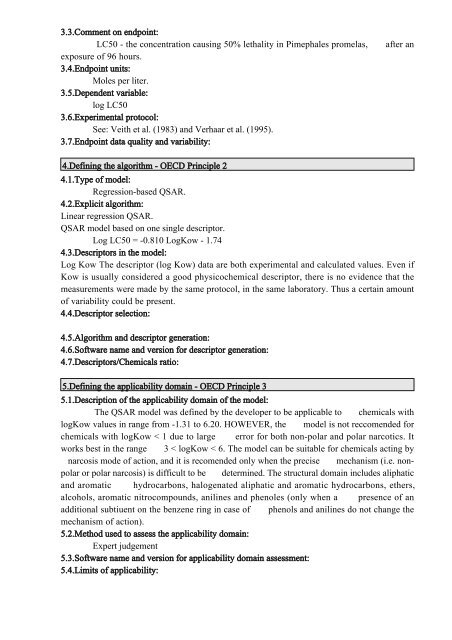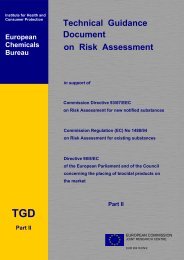QSAR model for narcosis (general) to fathead minnow, including ...
QSAR model for narcosis (general) to fathead minnow, including ...
QSAR model for narcosis (general) to fathead minnow, including ...
Create successful ePaper yourself
Turn your PDF publications into a flip-book with our unique Google optimized e-Paper software.
3.3.Comment on endpoint:<br />
LC50 - the concentration causing 50% lethality in Pimephales promelas, after an<br />
exposure of 96 hours.<br />
3.4.Endpoint units:<br />
Moles per liter.<br />
3.5.Dependent variable:<br />
log LC50<br />
3.6.Experimental pro<strong>to</strong>col:<br />
See: Veith et al. (1983) and Verhaar et al. (1995).<br />
3.7.Endpoint data quality and variability:<br />
4.Defining the algorithm - OECD Principle 2<br />
4.1.Type of <strong>model</strong>:<br />
Regression-based <strong>QSAR</strong>.<br />
4.2.Explicit algorithm:<br />
Linear regression <strong>QSAR</strong>.<br />
<strong>QSAR</strong> <strong>model</strong> based on one single descrip<strong>to</strong>r.<br />
Log LC50 = -0.810 LogKow - 1.74<br />
4.3.Descrip<strong>to</strong>rs in the <strong>model</strong>:<br />
Log Kow The descrip<strong>to</strong>r (log Kow) data are both experimental and calculated values. Even if<br />
Kow is usually considered a good physicochemical descrip<strong>to</strong>r, there is no evidence that the<br />
measurements were made by the same pro<strong>to</strong>col, in the same labora<strong>to</strong>ry. Thus a certain amount<br />
of variability could be present.<br />
4.4.Descrip<strong>to</strong>r selection:<br />
4.5.Algorithm and descrip<strong>to</strong>r generation:<br />
4.6.Software name and version <strong>for</strong> descrip<strong>to</strong>r generation:<br />
4.7.Descrip<strong>to</strong>rs/Chemicals ratio:<br />
5.Defining the applicability domain - OECD Principle 3<br />
5.1.Description of the applicability domain of the <strong>model</strong>:<br />
The <strong>QSAR</strong> <strong>model</strong> was defined by the developer <strong>to</strong> be applicable <strong>to</strong> chemicals with<br />
logKow values in range from -1.31 <strong>to</strong> 6.20. HOWEVER, the <strong>model</strong> is not reccomended <strong>for</strong><br />
chemicals with logKow < 1 due <strong>to</strong> large error <strong>for</strong> both non-polar and polar narcotics. It<br />
works best in the range 3 < logKow < 6. The <strong>model</strong> can be suitable <strong>for</strong> chemicals acting by<br />
<strong>narcosis</strong> mode of action, and it is recomended only when the precise mechanism (i.e. nonpolar<br />
or polar <strong>narcosis</strong>) is difficult <strong>to</strong> be determined. The structural domain includes aliphatic<br />
and aromatic hydrocarbons, halogenated aliphatic and aromatic hydrocarbons, ethers,<br />
alcohols, aromatic nitrocompounds, anilines and phenoles (only when a presence of an<br />
additional subtiuent on the benzene ring in case of phenols and anilines do not change the<br />
mechanism of action).<br />
5.2.Method used <strong>to</strong> assess the applicability domain:<br />
Expert judgement<br />
5.3.Software name and version <strong>for</strong> applicability domain assessment:<br />
5.4.Limits of applicability:








